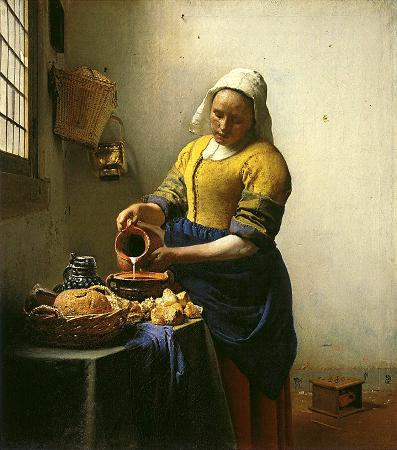Young Woman Seated at Virginals (c1670). Oil on canvas. 25 x 20. Sale $30,000,000 (2004, Sotheby's, L04031, 8). Young Woman Seated at the Virginals is a painting generally attributed to Johannes Vermeer, though this was for a long time widely questioned. A series of technical examinations from 1993 onwards confirmed the attribution. It is thought to date from c.1670 and is now in part of the Leiden Collection in New York. It should not be confused with Young Woman Seated at a Virginal in the National Gallery, London, also by Vermeer. The painting's early provenance is unclear, though possibly it was owned in Vermeer's lifetime by Pieter van Ruijven and later inherited by Jacob Dissius. By 1904 it was one of two Vermeers owned by Alfred Beit, the other being Lady Writing a Letter with her Maid. It remained in the Beit family until sold to Baron Rolin in 1960. The painting was not widely known until described in the catalogue of the Beit collection published in 1904. In the first decades following 1904 it was widely accepted as a Vermeer. Then in the mid-twentieth century, as some Vermeers were discovered to be forgeries by Han van Meegeren and doubt was cast on others, it fell from favour. In 1993 Baron Rolin asked Sotheby's to conduct research into the painting. A series of technical examinations followed, which have convinced most experts that it is a Vermeer, though probably one that was reworked in parts after the painter's death. Rolin's heirs sold the painting through Sotheby's in 2004 to Steve Wynn for $30 million. It was later purchased for the Leiden Collection owned by Thomas Kaplan. It has appeared in several Vermeer exhibitions in recent years, in the United States, Britain, Japan, Italy and France. The painting originally had the same dimensions as Vermeer's Lacemaker. Tentative evidence that the canvas was cut from the same bolt as the Lacemaker, which was gathered in the 1990s, was strengthened by a later, more sophisticated study. The ground appears identical to that used for the two Vermeers owned by London's National Gallery. X-ray examination has revealed evidence of a pin-hole at the vanishing point, as habitually used by Vermeer in conjunction with a thread to achieve correct perspective in his paintings. Pigments are used in the painting in a way typical of Vermeer, most notably the expensive ultramarine as a component in the background wall. The use of green earth in shadows is also distinctive. The use of lead-tin-yellow suggests that the painting cannot be a nineteenth-or twentieth-century fake or imitation. Examination of the cloak, often cited as the crudest part of the painting, shows that it was painted over another garment after some time had elapsed. It is not known how long this gap was, or if Vermeer was responsible for the repainting. The hairstyle can be dated to c.1670, and matches the hairstyle in the Lacemaker, which on other grounds is also often dated to the same period. It is not clear if the painting was completed before or after the similar but more ambitious Young Woman Seated at a Virginal in the National Gallery, London. The painting is unsigned. Walter Liedtke has described the painting as a minor late work by Vermeer. The colour scheme is typical of Vermeer's mature work. The luminosity and finely modelled passages of the young woman's skirt recall the Lady Standing at a Virginal and are often cited as the painting's best feature, contrasting with the less skillfully painted cloak which may be the work of a later artist. The blurring of objects in the foreground, the quality of the light and the attention paid to the texture of the wall are typical of Vermeer, while the handling of the pearls in the woman's hair recalls the threads spilling from the cushion in the Lacemaker.
more...



